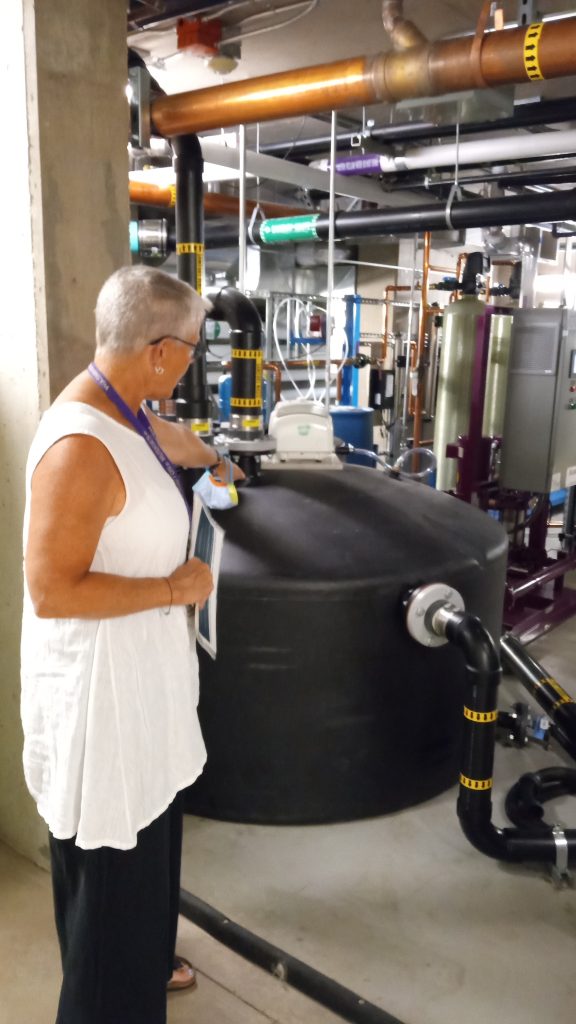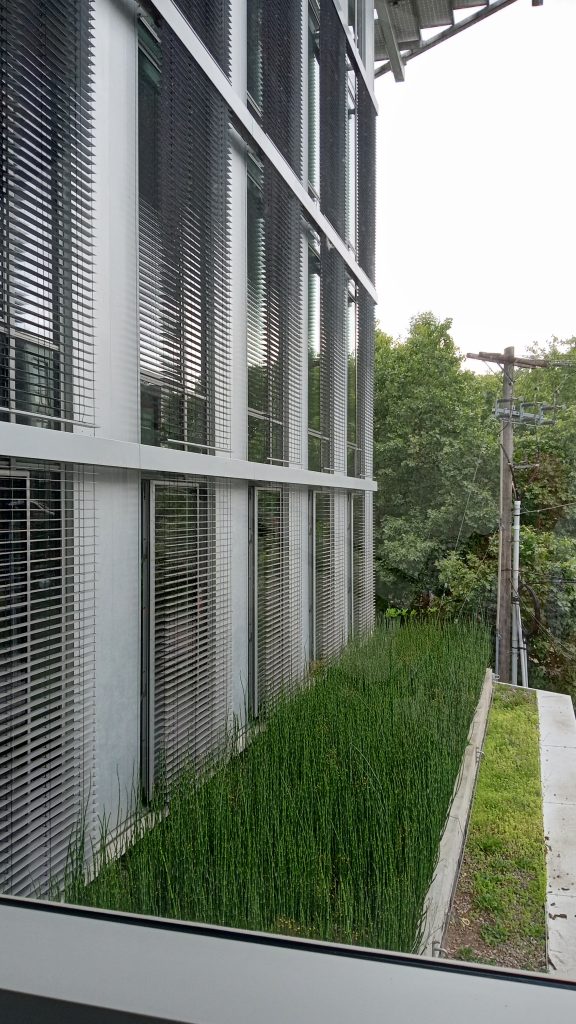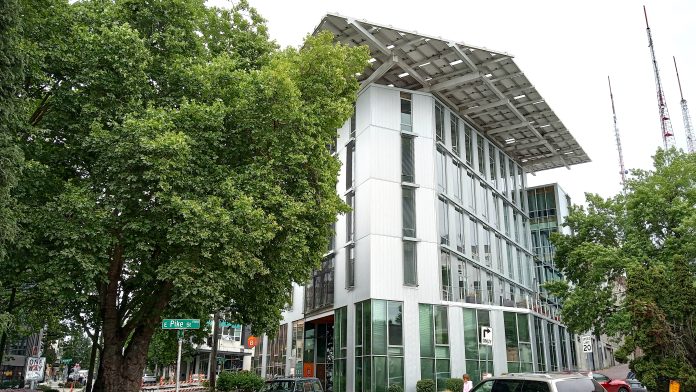
“Those who assume that a net-zero building like the Bullitt Center is either too expensive to be profitable or requires cutting edge technology are mistaken.”
When the Bullitt Center – the world’s first commercial building to achieve net-zero use of energy and water – opened in Seattle in 2013, it was an exceptional building.
Ten years later, it still is.
“Sadly, it’s still rare,” said Deborah Sigler, education and outreach coordinator for the University of Washington’s Center for Integrated Design, which is housed in the Bullitt Center. “But I’m also happy it’s still on people’s radars. It’s just as relevant as it was 10 years ago.”
Sigler leads scores of tours of the six-story building on Madison Street each year, introducing architecture students, policymakers, and environmentalists to one of the few projects completely certified according to Living Building Challenge 2.0 standards. (Those standards have now evolved into Living Building Challenge 4.0.)
Jason McLennan, who created this system of seven “petals” that make up the Living Building Challenge, said the Bullitt Center stands out as the shining example of a truly sustainable building.
“We’re still using it as a teaching tool,” said McLennan, who serves on the board of the International Living Future Institute, which continues to promote living buildings. “A month ago I was in Australia, and we used it as a case study for a major conference there. So it continues to inspire and to be a benchmark.”
Unlike other green building standards such as LEED, the Living Building Challenge is founded on seven principles that a building must meet not only in the design and construction, but also in operation: net-zero energy use, net-zero water use, sustainable materials, site-specific design, and significant attention to health, equity, and beauty.
Lindsay Baker, the CEO of the International Living Future Institute, said that only about 40 buildings worldwide have fully met the ambitious standards of the Living Building Challenge. “We want these buildings to serve as beacons for change,” Baker said. “They need to be examples to the community that allow us to change policy.”
In fact, when Denis Hayes, Bullitt Foundation CEO and the visionary behind the Bullitt Center, first pushed the project forward, his team had to engage in many hours of negotiation and persuasion with Seattle Department of Construction & Inspections (SDCI) to create exceptions to existing code. SDCI went on to create a pilot project that would, among other things, allow for buildings that could collect and treat rainwater or process their own wastewater.
Sigler remembers a time she was giving a tour to architecture students a few years ago and one of them asked Hayes what was one thing they could do to make the biggest impact in terms of the climate impact of buildings. He said: “Change the code,” Sigler said.
SDCI’s Living Building Challenge Pilot incentive program was created to encourage developers to certify their buildings for at least partial certification of some of the “petals” of the Living Building Challenge. To receive additional height and floor-area-ratio allowances, a building needs to either meet the full challenge, or meet one of the core water, energy, or materials petal of the challenge, plus exceed Seattle Energy Code efficiency targets by more than 25 percent, as well as significantly reducing potable water needs by using non-potable water for toilet flushing and irrigation.
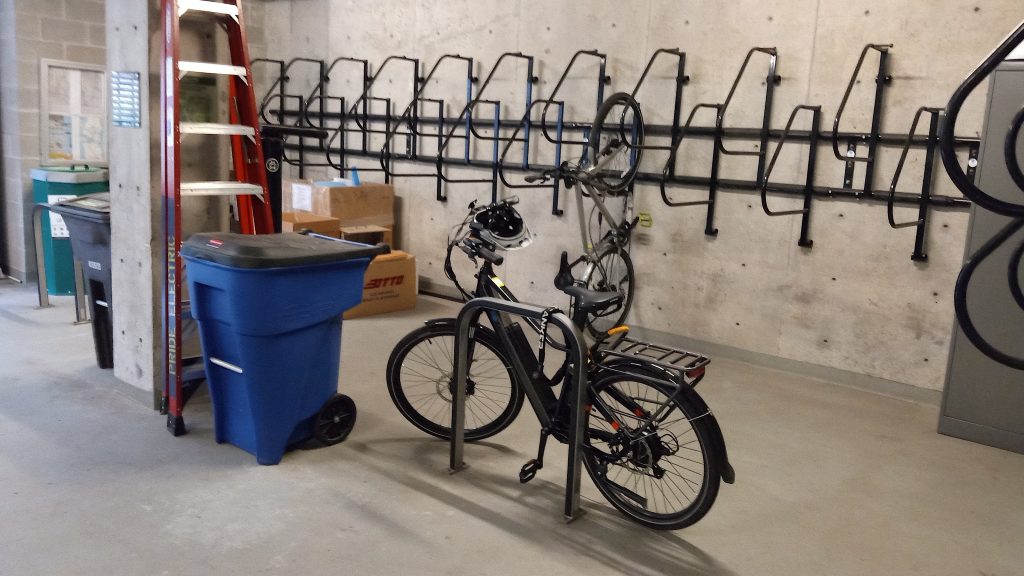
According to Jess Harris, green building program manager for SDCI, two projects have completed that certification – the Bullitt Center and Stone34, a mixed-use commercial building in Fremont which houses the headquarters of Brooks Running. In addition, a total of 13 projects are now in the pipeline to meet SDCI’s standards for its Living Building Challenge pilot, Harris said. The program is well on its way to meet a goal of 20 certifications by 2030. Harris said extending the pilot beyond 20 buildings would require action by the Seattle City Council.
Certification in SDCI’s program includes a one-year evaluation to determine if the building actively meets its net-zero goals. That’s also one of the most distinctive elements of the global Living Building Challenge that sets it apart from other green certifications such as LEED: building owners have to demonstrate that their project actively achieves its sustainability goals over a 12-month period.
“Performance is really impacted by human behavior,” Baker said. “So we do ask for a full year of performance at the level people are aspiring to before we certify.”
Among the 13 buildings hoping to achieve SDCI’s partial Living Building Certification incentives is The Watershed Building in Fremont, a mixed-use green building that meets three of the seven Living Building petals. One of its most distinctive features are terraced bioswale and bioretention gardens that capture dirty runoff from the Aurora Bridge and Troll Avenue, filtering out toxic runoff.
“By the time the water actually gets to Lake Union, the particulates that have been killing the salmon that come off of the tires of cars are filtered out,” Sigler said.
Other buildings in SDCI’s pilot include a five-story office building at 3524 Stone Way N, a 15-story, 112-unit apartment building at 303 Battery Street, a 7-story, 207-unit apartment building with retail at 2517 Eastlake Avenue E, and a 6-story, 24-unit apartment building at 6817 Greenwood Avenue N.
One completed project, Harris said, did not pass the one-year operational test, and faced a fine as a result.
In the 10 years that the Bullitt Center has been in operation, architects, developers and building managers have had the opportunity to learn lessons from this project in the vanguard of net-zero buildings.
Some aspects of the building exceeded expectations, Sigler said – most notably, energy use and generation. “When the building was designed, we had no idea at the time that we would be as net-positive as we are,” she said.
A white paper published in 2014 by UW’s Center for Integrated Design examined the lessons learned from the building, noting that “The Bullitt Center is an audacious and provocative experiment. It challenges expectations for how efficiently a modern office building can operate.” The white paper reiterates: The Bullitt Foundation chose to pursue the more rigorous Living Building Challenge™ (LBC) because it is performance-based. In selecting the LBC for green certification of the Bullitt Center, Denis Hayes said, “We no longer have time for good intentions, to check-off boxes that say we’ve done this and done that, but result in a building that doesn’t perform as it was designed to perform.” While the systems designs were bold, most are performing very well.
Sigler notes that the building’s rooftop solar panels generate around 244,000 kilowatt hours of energy per year, about what building designers expected. But the Bullitt Center sells much more power back to Seattle City Light than anticipated because of better-than-expected performance from the building’s climate-control features.
Those include natural ventilation and passive cooling, automatically controlled exterior blinds that continually adjust based on the location of the sun, and a ground source heat pump that generates both heat and cooling through a series of pipes that reach to a depth of 400 feet below the building.
The Bullitt Center’s Energy Use Index (EUI) is currently around 13 kBTU per square foot (sf) year, better than the 16 kBTU/sf that project engineers PAE Consulting predicted, and much better than the current office building average in Seattle, which is around 50 kBTUS/sf year, Sigler said.
Sigler acknowledges that the building’s overall energy use has also declined slightly since the pandemic, but this hasn’t been a huge factor in the net-positive energy balance. The building was largely empty during the height of COVID-19, but occupancy has now climbed back to 78%. Salley Anderson, CFO of the Bullitt Foundation, estimates that those clients have staff in their offices about 60% of the time on average.
The water treatment system has also performed well. Potable water for drinking, showers, and dishwashers is first collected in a 56,000-gallon cistern and then filtered and treated with ultraviolet light and chlorine. The greywater waste from those sinks, showers and dishwashers is filtered and treated with UV-light and re-used to flush toilets. Excess greywater is pumped into an on-site wetlands garden.
What didn’t perform as well as expected, said Sigler, were the Bullitt Center’s composting toilets, which were replaced in 2021 with a vacuum-based toilet system. The composting toilet system, which had used foam-based flushing and 10 composters in the building’s basement, proved to be problematic. Fans were needed to run continuously to vent odors, trucks were required to haul the composted waste to a site 52 miles away (adding to the building’s carbon footprint) and the building’s maintenance personnel spent roughly half their total time dealing with issues related to the toilets.
The current vacuum-based system, which Sigler said cost about $1 million to retrofit the entire building, uses just 0.4 gallons per flush. The system grinds and separates out solids, and the remaining sewage is piped to King County Metro’s treatment facility.
One of the projects that’s taken lessons from the Bullitt’s Center’s experience with its toilet system is the PAE Living Building in Portland, which is home to PAE Consulting, which also worked on the Bullitt Center. That building in Portland, which incorporates vacuum-based toilets, is the world’s first developer-led project that aims to achieve full Living Building Certification. The five-story office building was created to last 500 years and utilizes cross-laminated timber certified by the Forest Stewardship Council (FSC).
Cross-laminated technology wasn’t quite available when the Bullitt Center was designed by Miller Hull architects, said Sigler, noting that glue-laminated FSC timber was used exclusively in framing. The building was the first wood-timber office building constructed in Seattle since 1927.
During our tour of the building, we entered a small loading area in the basement with a few recycling bins and several bicycles. Sigler pointed out that the building has a walkability score of 99 out of 100 and was designed to be accessed by walking, cycling and transit. “I tell people you’re standing in an example of a 21st century parking garage,” she said. “They look around and chuckle because all they see are racks for bicycles – and that of course was very intentional.”
We then ascended the building’s famous “irresistible staircase,” a bright, wood-framed stairway that technically serves as a fire escape but was designed to attract people to prefer it rather than the building’s elevator, which primarily serves those with disabilities or who need extra assistance.
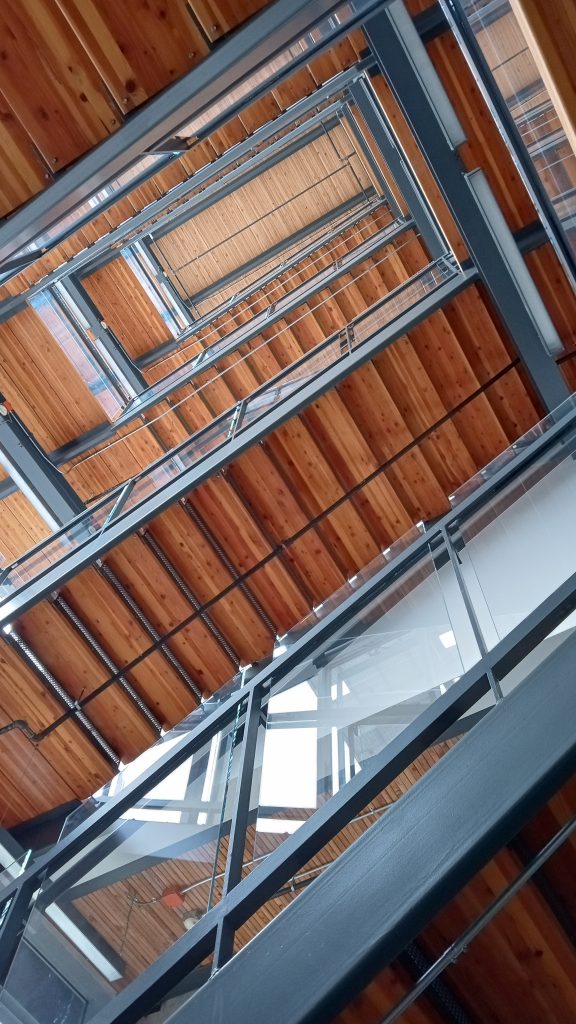
At the end of our tour, we took in the expansive view from one of the office spaces – and even though it was a cloudy day, the light inside the building was palpable. “The organization of each floor plan is designed to meet the equity imperatives,” Sigler said, “so that everybody who works in this building gets equal access to daylight and natural ventilation.”
Sigler said that those who assume that a net-zero building like the Bullitt Center is either too expensive to be profitable or requires cutting edge technology are mistaken.
“The technology in this building is all off the shelf,” she said. “There’s nothing in this building that’s state of the art.” She noted that the $32 million price tag for the Bullitt Center was about 23% above the cost of a similar building built to code in 2013. “But much of that premium had to do with changing the codes to bring down the barriers to building the building in the first place,” she said.
Sigler said local and state governments will need to fund incentives and pass more restrictive energy code legislation in order to push developers to create truly green buildings like the Bullitt Center. Time is running out, she said.
“Do you want to live? Do you want to breathe clean air? Or do you want to cook yourself to death? Because that’s essentially what we’re doing if we continue to behave the way we’ve behaved for the last 150 years.”

Andrew Engelson
Andrew Engelson is an award-winning freelance journalist and editor with over 20 years of experience. Most recently serving as News Director/Deputy Assistant at the South Seattle Emerald, Andrew was also the founder and editor of Cascadia Magazine. His journalism, essays, and writing have appeared in the South Seattle Emerald, The Stranger, Crosscut, Real Change, Seattle Weekly, the Seattle Post-Intelligencer, the Seattle Times, Washington Trails, and many other publications. He’s passionate about narrative journalism on a range of topics, including the environment, climate change, social justice, arts, culture, and science. He’s the winner of several first place awards from the Western Washington Chapter of the Society of Professional Journalists.

